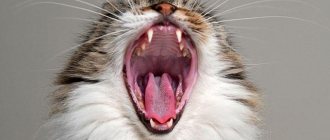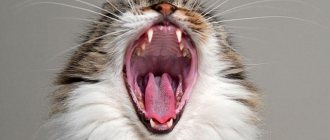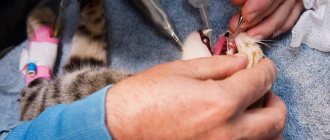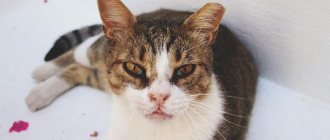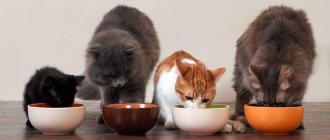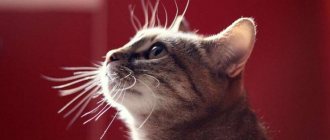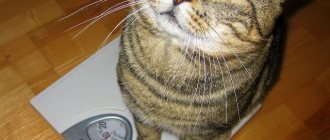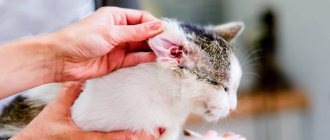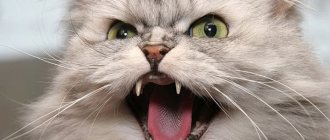Cats' teeth can normally fall out only twice in their life: in childhood - when changing from a primary bite to a permanent one - and in old age. All other cases are associated with diseases and genetic factors.
Some breeds are prone to oral problems and calcium metabolism disorders, so it is important to carefully select a kitten from a pure line.
Why does a cat's teeth fall out?
The causes of tooth loss are divided into physiological and pathological. Physiological ones include replacing primary dentures with permanent ones. Irreversible loss occurs for pathological reasons.
Physiological change of teeth
Kittens begin to develop their first teeth at two weeks of age. A two-month-old kitten has 26 dents. In kittens over 100 days old, teeth begin to change to permanent ones and, on average, the process ends by seven months of age.
A one-year-old cat is no longer considered a kitten and has 30 teeth.
Pathological causes
There are congenital and acquired causes of premature dental loss.
The following are genetically determined:
- multiple teeth;
- sparse teeth;
- placement of teeth in the wrong places;
The following malocclusions occur in genetically predisposed animals:
- undershot - the lower jaw is shorter than the upper jaw;
- snack: on the contrary, a cat’s jaws resemble those of a bulldog;
- skewed mouth: occurs when one half of the muzzle grows faster than the other.
A precondition for the occurrence of acquired causes of dental loss is the formation of tartar (dentolite). The development of pathology is facilitated by the owners' approving attitude towards begging. Soft food sticks to the gums. A yellowish coating forms, on which opportunistic microbes that live in the mouth or on food particles settle.
Be sure to read:
Interpretation of blood tests in cats: features of the procedure, types, main indicators, norms
With the resulting film, calcium salts crystallized from saliva enter the adhesive joint. The accumulated mass hardens and tartar or dentolitis forms. Under the hard surface, anaerobic conditions arise, under which putrefactive microflora rapidly develops.
Dentolitis leads to the following diseases:
- Gingivitis : inflammation of the gums, which the cat owner recognizes by halitosis - an unpleasant odor and excessive drooling. The cat loses its appetite because it hurts to chew. The mucous membranes bleed. The pet responds to touching the gums with aggression.
- Caries - rotting. Pathogenesis includes a successive change of stages of the disease - superficial, medial, deep. The enamel becomes dark brown, making it painful for the cat to chew. Drooling develops. The mouth smells bad.
- Osteomyelitis is the next stage of caries. Inflammation spreads to bone tissue. Gum pockets filled with pus form. Abscesses form. Tissues melt and fistulas form. Local lymph nodes are enlarged.
- Periodontitis is characterized by the slow destruction of the ligaments that hold the teeth in the gums. The dents wobble and fall out.
Milk teeth and their replacement
In most cases, kittens are born without teeth. Milk teeth erupt at 7-14 days of age. When a kitten reaches 2 months of age, it should have 26 teeth. Baby teeth begin to fall out when the kitten is about 3-4 months old and this process lasts about 3-4 months. If your kitten is 7 months or younger, then teeth may fall out and this is normal. Monitor your pet's overall health, as well as the condition of his gums and teeth, count how many teeth have fallen out and which ones.
© shutterstock
The replacement of milk teeth with permanent ones occurs with the following symptoms::
- excessive salivation;
- decreased activity;
- increased excitability;
- chewing surrounding objects.
In a cat, the replacement of teeth with permanent ones should be completed by approximately 7 months of age. An adult animal should have 30 teeth: 12 incisors (6 each on the upper and lower jaws), 4 canines (2 on both jaws), 10 premolars (4 on the upper and 6 lower jaws) and 4 molars (2 on each jaws).
Loss of teeth in cats in old age
Cats that have crossed the seven-year mark are considered elderly. Manufacturers of ready-made food make special food for cats over 7 years old. By this age, pets are excluded from breeding and are recommended to be neutered.
The process of teeth abrasion begins. However, everything is individual. There are fifteen-year-old pets. retaining all the dents.
The first incisors fall out at the age of 9; the pet loses its fangs after the thirteenth birthday.
Kitten care
When replacing milk teeth with permanent ones, caring owners should create special conditions for keeping the cat, its nutrition, oral hygiene and general purring behavior.
Kitten oral hygiene
A cat should be accustomed to cleaning from the first months of life, so as not to be tormented later with an adult cat. Veterinarians advise starting with a game - let the little purr get used to his toothbrush. This way he won't be afraid of her.
Later, the kitten will even appreciate the opportunity to scratch his itchy gums on the bristly surface of the brush.
Hygiene procedures for the kitten's oral cavity should be performed 1-2 times a month. This procedure is an excellent prevention of periodontitis and tartar.
Nutritional Features
A small pet should be fed taking into account its age characteristics, regardless of the replacement of fangs. Caring owners should know that the health of a kitten’s oral cavity is promoted by food rich in phosphorus, calcium, as well as vitamins A and D. The cat will benefit from: boiled lean meat and fish, rice and oatmeal, milk, kefir, cottage cheese, pumpkin and zucchini.
When feeding industrial food, preference should be given to products made directly for kittens. Such food contains a balanced vitamin and mineral complex, specially designed for the growth of a young cat's body.
By eating such food, the kitten receives the proper amount of microelements necessary for oral health.
How to behave with a pet
Itching in the gum area during the eruption of incisors and fangs always causes stress in kittens. During this period, owners are encouraged to correct the cat's behavior. You should not allow your cat to chew on anything - this can harm the baby’s health.
During these several months, it is better not to vaccinate the purr, so that the vaccination does not harm its health.
What cat breeds are prone to early tooth loss?
Breeds of animals that are bred for commercial purposes are predisposed to developmental anomalies. Spontaneous selection has led to the appearance among short-faced pets of individuals predisposed to premature loss of teeth.
These include cats of the following breeds:
- Persov;
- Exotics;
- Burmantsev;
- Ragdoll;
- Britanov;
- Scots;
- Abyssinok.
Conscientious felinologists exclude pets with dental anomalies from breeding.
Prosthetics for cats
Prosthetics are also used in veterinary medicine. Dental prosthetics are often given to cats participating in exhibitions so that they do not lose their grades. But it is worth considering the disadvantages that arise from prosthetics:
- Cats often wear down their tooth enamel, which increases the chances of caries;
- dentures can injure the gums and palate of cats, which can result in inflammation;
- implants and pins may not take root well;
- Dental prosthetics for cats is a fairly expensive undertaking.
Thus, if a missing tooth does not cause your pet much discomfort, dentures may even do more harm than good. It only makes sense to use them from an aesthetic point of view.
Preventing tooth loss in cats
To prevent premature tooth loss, kittens are given dental bones, which are both toys and mineral supplements. If it is noticed that dental plaque is forming in pets, then Hill's t/d therapeutic food is used for oral hygiene in cats.
Children are explained why cats should not be treated with human treats. An alternative to nutritional therapy is to train your cat to brush its teeth.
Or rather, do not resist when the owner does this. Of course, for this they use a paste and a brush intended for cats. An attempt to clean the teeth with human instruments will cause the pet to persistently reject the hygiene procedure.
If the formation of tartar was missed, children and household members who were unable to grow up were not weaned off the habit of treating their pets with treats, they refused to switch to ready-made food, and you will have to spend money on teeth cleaning at the clinic. The operation is performed under anesthesia using ultrasound.
How to help a cat
What to do if a cat’s teeth fall out is a rather complex question that cannot be answered unequivocally. Depending on the reasons, the method to solve the problem will be different.
© shutterstock
First of all, it is necessary to observe the animal whose tooth has fallen out and note (preferably write down) any changes in its habitual behavior. This could be a change in activity, a change in character, or a refusal to eat. And also more obvious signs - bad breath, the presence of bloody or purulent discharge from the oral cavity. All this data is necessary for the veterinarian to determine what examinations are needed for an animal whose tooth has fallen out. This information will also help in making a diagnosis.
Depending on why the tooth fell out, the following solutions to the problem may be suggested::
- choosing the right diet;
- taking medications to strengthen the immune system and teeth;
- treatment of gum diseases;
- removal of tartar;
- treatment of the underlying disease.
Most often, a cat's teeth begin to loosen and fall out due to tartar. The veterinarian will suggest scaling. This procedure is usually performed under general anesthesia. However, it is best to carry it out under so-called “premedication”. These drugs cause less harm to the pet's health. During the procedure, the animal will be conscious (which will be stressful for it), but will not be able to resist. After this, the cat needs the same care as after general anesthesia for 24 hours.
Treatment in dentistry
To eliminate pathological abrasion of hard dental tissues, you need to establish its cause and then get rid of it. The next step is to restore the configuration of the dentition. In the early stages, treatment with medications may be sufficient. If the symptoms are pronounced, only an orthopedist will help.
Medicines
The techniques used are based on the process of remineralization of the enamel layer. In this way, compensatory reactions are activated and mineral metabolism in hard tissues is normalized. Experts prescribe vitamin and mineral supplements with a high content of calcium and phosphorus. Additionally, pastes are used to reduce sensitivity. If the destruction has just begun and the dentin has not been damaged, this option for treating tooth wear can be very effective.
Orthopedic methods
If the defect is serious, medication alone is not enough; more radical correction is required. Most often, doctors use inlays and artificial crowns. If some units fall out, a bridge structure, clasp prosthesis or other types are installed. This therapy allows you to completely restore the functioning of the rows and evenly distribute the chewing load.
Diagnostics
Most people aged 50 years and older experience the physiological type of abrasion. The doctor needs to determine in time when the natural process turns into a pathological one. One of the main methods remains measuring the actual parameters of crowns. In addition, it is important to carefully study the shape of the dental units and determine areas of contact with antagonists. The height of the coronal part is compared with age standards established scientifically.
Diagnostic measures include assessment of fissures and enamel condition. The doctor pays attention to the patient’s facial expressions and appearance. It is important to talk in detail about your complaints and describe your feelings.
To assess how correctly the temporomandibular joint functions, electromyography is indicated. X-ray examination, electroodontodiagnosis and other procedures are carried out.
Associated symptoms
Tooth loss is always accompanied by clinical symptoms that will indicate to owners the presence of problems in the oral cavity. These include:
- unpleasant odor from the mouth;
- increased salivation;
- soreness, redness, possible bleeding of the gums;
- loss of appetite or complete refusal to eat;
- presence of loose teeth.
If it is not possible to immediately go to the clinic, then you should rinse the cat’s mouth with a decoction of chamomile, calendula or oak bark.
Important! It is forbidden to use antibiotics for treatment or try to remove a tooth that is loose on your own.
When is veterinary help needed?
The owner should focus on the pet’s well-being and his own common sense. Often, symptoms when kittens change teeth make the owner worry about the baby’s health.
Veterinarians are quite loyal to situations when the owner brings a healthy kitten to the appointment to make sure that everything is fine with him. This is definitely better than not seeing a doctor when you definitely need his help.
Regarding the change of teeth, a veterinarian is definitely needed in the following situations:
- the wound on the site of the former baby tooth has festered;
- the cat meows pitifully, cannot sleep, is worried;
- the animal is very lethargic;
- the kitten does not eat for more than a day;
- the baby's mouth smells bad;
- the gums are very inflamed;
- a new tooth or an old one displaced under its influence injures the kitten;
- the baby tooth never fell out, but the gums around it were inflamed;
- the cat has not gone to the toilet for more than a day (he scratched his teeth on something, bit off a piece, and it got stuck in the intestines);
- Some of the baby teeth have not fallen out, although the permanent ones have already grown in and the time for changing teeth has passed.
Deterioration in health cannot always be attributed to the teeth; perhaps the pet is sick. A doctor's consultation will be required in the following situations:
- The smell becomes disgusting, which signals severe inflammation and the development of periodontal disease.
- The kitten sleeps poorly, does not eat for more than a day, and becomes apathetic or restless. A possible reason for this behavior is severe pain in the gums.
- Saliva is secreted excessively, thickens, hangs out of the mouth, which causes the fur on the chest to become wet. This indicates a possible inflammation of the oral mucosa - gingivitis, stomatitis.
The pet's mouth is regularly examined; normally, the surfaces remain smooth, pink, and without damage. Help is needed when deviations are noticed:
- the gum is inflamed around the temporary tooth;
- the hole festered;
- the “milk jug” has shifted and injures the mucous surfaces;
- some children’s teeth remain when the permanent ones are fully grown;
- after 7 months a double row was formed;
- The gums are red and bleeding.
In case of inflammation, they do not give medicine, but take the pet to the clinic. Only a veterinarian will be able to properly examine the mouth, assess the degree of inflammation, and prescribe medications without harm to the animal’s health. “Excess” teeth are removed in the clinic under anesthesia if they damage the mucous membranes, form an incorrect bite, or remain in the mouth after 8–9 months. Stunted growth, when milk has already fallen out, indicates a lack of microelements.
Consequences of tooth extraction
Complications are possible after the removal procedure. You will immediately understand that your animal is experiencing discomfort or pain. The cat will refuse to eat, will worry, meow loudly, and rush around the house.
Common complications include the following:
Alveolitis. Bad breath, refusal to eat, quickly swallowing pieces without chewing are signs of gum inflammation. The treatment is quick and painless. The doctor cleans the inflamed hole and applies a bandage with disinfecting ointment.
Bleeding. If there is excessive bleeding, the hole must be sutured.
Jaw fracture. It can only be detected by injury during removal, if the doctor applied too much physical force to the jaw.
Unfortunately, tooth extraction in cats is quite common, since many animal owners, out of ignorance, do not care for the cat’s oral cavity. Therefore, they come to the clinic with advanced cases and the teeth are removed.
Tooth extraction in cats occurs only when treatment no longer helps. It must be remembered that many dental diseases are asymptomatic, so it is necessary to periodically examine the oral cavity so that you do not have to resort to such a procedure.
Let's look at the cases in which teeth are removed.
- Incorrect placement of milk or molars, which interferes with the normal functioning of the animal - the soft tissues of the oral cavity are damaged.
- In severe cases, where conventional treatment has not yielded results - feline lymphoplasmacytic stomatitis.
- Teeth that are close to each other is called crowding. In this case, there is a risk of getting sick because Food will accumulate between the teeth and this will lead to an inflammatory process.
- Internal root resorption
- External root resorption
- Milk teeth that did not fall out on time on their own, but the molars have already begun to grow and the milk teeth interfere with the growth of new teeth.
- Teeth located under the gum mucosa are also subject to removal. They have not erupted, but a cyst may form under the gum and this will harm the adjacent teeth.
- The indication for tooth extraction is periodontal disease.
- Odontoclastic resorptive lesion of teeth – classes 2,3,4
Tooth extraction is carried out only under anesthesia. After tooth extraction, your pet must have the wound sutured, otherwise there is a risk of infection, and the wound will take a long time to heal.
Let's sum it up
What to do if the lower front teeth or upper teeth are worn out, pain and other unpleasant symptoms appear? First of all, you need to go to the dentist to conduct a thorough diagnosis and identify the exact causes of the pathology. The longer the patient ignores the presenting signs, the more severe the consequences for him. In order not to encounter this phenomenon, it is necessary to take preventive measures, especially for those at risk.
Sometimes the enamel wears away due to age-related changes. In this case we are talking about a natural process. Which group should the problem be classified into, and whether treatment should be prescribed, should be decided solely by the doctor.
Complications
What to do if teeth are worn out depends on the provoking factors. As discussed above, the lack of timely therapy leads to cosmetic defects and disruption of the chewing process. In addition, there are other consequences that affect the quality of life of patients:
- inflammation of the gums in the interdental spaces;
- gingivitis;
- diseases of the temporomandibular joint;
- loss of teeth;
- damage to nerve fibers and muscle tissue;
- uneven load distribution leading to traumatic articulation;
- malocclusion.
